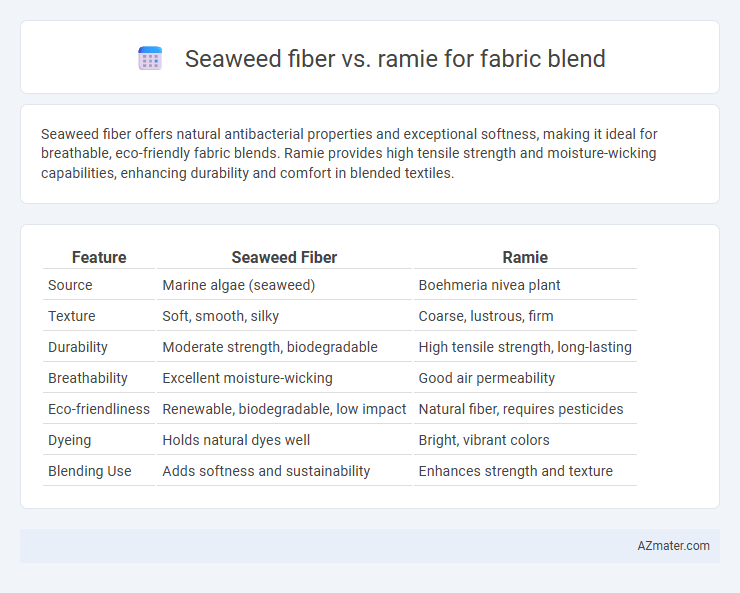Seaweed fiber offers natural antibacterial properties and exceptional softness, making it ideal for breathable, eco-friendly fabric blends. Ramie provides high tensile strength and moisture-wicking capabilities, enhancing durability and comfort in blended textiles.
Table of Comparison
| Feature | Seaweed Fiber | Ramie |
|---|---|---|
| Source | Marine algae (seaweed) | Boehmeria nivea plant |
| Texture | Soft, smooth, silky | Coarse, lustrous, firm |
| Durability | Moderate strength, biodegradable | High tensile strength, long-lasting |
| Breathability | Excellent moisture-wicking | Good air permeability |
| Eco-friendliness | Renewable, biodegradable, low impact | Natural fiber, requires pesticides |
| Dyeing | Holds natural dyes well | Bright, vibrant colors |
| Blending Use | Adds softness and sustainability | Enhances strength and texture |
Introduction to Seaweed Fiber and Ramie
Seaweed fiber, derived from sustainably harvested seaweed and processed into soft, breathable yarn, offers natural antibacterial and UV-resistant properties, making it ideal for eco-friendly fabric blends. Ramie, a bast fiber extracted from the stalks of the Chinese nettle plant, is known for its exceptional strength, silky luster, and moisture-wicking abilities, enhancing durability and comfort in textile applications. Blending seaweed fiber with ramie combines seaweed's bioactive benefits and softness with ramie's resilience and sheen, resulting in innovative, sustainable fabrics with enhanced performance.
Origins and Production Processes
Seaweed fiber is derived from marine algae, primarily harvested from coastal regions where sustainable seaweed farming is practiced, offering an eco-friendly alternative in textile production. Ramie originates from the stalks of the Chinese nettle plant, cultivated mainly in East Asia, undergoing a labor-intensive process of retting and degumming to extract fine, lustrous fibers. The production of seaweed fiber involves bio-extraction techniques that preserve the fiber's natural properties, whereas ramie processing relies on traditional methods to produce strong, breathable fabric blends.
Physical Properties Comparison
Seaweed fiber exhibits excellent moisture absorption and breathability, making it ideal for comfortable fabric blends, while ramie offers superior tensile strength and durability due to its long, lustrous fibers. Seaweed fiber is naturally antibacterial and lightweight, enhancing fabric softness and skin-friendliness, whereas ramie's high resistance to wrinkling and mold adds to the fabric's longevity. Combining seaweed fiber with ramie in fabric blends creates a balance of softness, durability, and moisture management, optimizing physical properties for versatile textile applications.
Environmental Impact and Sustainability
Seaweed fiber offers a biodegradable and renewable alternative with low water usage and natural antibacterial properties, making it highly sustainable compared to traditional fibers. Ramie, a bast fiber derived from the stalks of the Boehmeria plant, requires minimal pesticides and grows quickly, contributing to its eco-friendly profile. Blending seaweed fiber with ramie enhances fabric durability and reduces environmental impact by combining two fibers known for their low ecological footprint and biodegradability.
Comfort and Breathability Analysis
Seaweed fiber offers superior moisture-wicking properties and natural antibacterial benefits, enhancing comfort in fabric blends by keeping the skin dry and fresh. Ramie provides excellent breathability and a smooth texture, contributing to a lightweight and airy fabric ideal for warm climates. Combining seaweed fiber with ramie creates a blend that maximizes comfort through enhanced airflow and moisture management, making it suitable for activewear and summer apparel.
Strength and Durability Factors
Seaweed fiber offers moderate strength and flexibility, making it suitable for lightweight fabric blends but less durable under heavy wear compared to ramie. Ramie stands out for its superior tensile strength and resistance to abrasion, enhancing fabric longevity and maintaining shape after multiple washes. Blending seaweed fiber with ramie combines natural softness with reinforced durability, optimizing the fabric for both comfort and extended use.
Dyeability and Color Retention
Seaweed fiber exhibits excellent dyeability due to its natural absorbent properties, allowing vibrant and long-lasting colors in fabric blends. Ramie, known for its smooth and lustrous surface, absorbs dyes well but can sometimes result in less intense shades compared to seaweed fiber. Fabrics blended with seaweed fiber demonstrate superior color retention and resistance to fading, making them ideal for garments requiring durable and vivid hues.
Cost and Commercial Availability
Seaweed fiber remains a niche material with limited commercial availability and higher production costs compared to ramie, which is widely grown and processed, ensuring steady supply at lower prices. Ramie's established cultivation and mature processing techniques contribute to its cost-effectiveness and scalability in fabric blends. Manufacturers seeking innovative textiles balance seaweed fiber's sustainability benefits against ramie's affordability and reliable market presence.
Common Fabric Blends and Applications
Seaweed fiber blends with ramie create sustainable fabrics combining seaweed's natural antibacterial properties and ramie's strength and durability. Common blends integrate 20-40% seaweed fiber with ramie to enhance moisture-wicking and softness, ideal for activewear, casual apparel, and eco-friendly textiles. These blends are popular in lightweight shirts, dresses, and home textiles due to their breathability, biodegradability, and smooth texture.
Future Trends and Innovations
Seaweed fiber and ramie are emerging as sustainable alternatives in fabric blends, driven by increasing consumer demand for eco-friendly textiles. Seaweed fiber offers natural biodegradability and skin-soothing properties, while ramie provides strength and breathability, making their combination ideal for high-performance, sustainable fabrics. Innovations focus on enhancing fiber processing techniques to improve texture and durability, positioning these blends as key players in the future of green fashion and smart textiles.

Infographic: Seaweed fiber vs Ramie for Fabric blend
 azmater.com
azmater.com